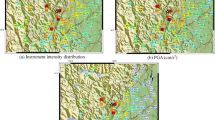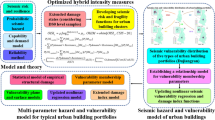Abstract
Evaluating the seismic vulnerability of regional group structures is essential for effectively quantifying the seismic resilience and risk analysis of regional cities. To study the degree of damage caused by a typical earthquake to the overall group of buildings in a specific area, this paper takes the field observation data of the Wenchuan earthquake on May 12, 2008, in China as the research background and makes empirical vulnerability statistics and classification on all the inspection data of structural groups in Dujiangyan city. The seismic risk experience database (8621 building samples) based on the overall regional group buildings is developed. Using nonlinear regression, probabilistic risk prediction, and a cumulative damage conditional probability model, the empirical vulnerability matrices of six typical groups of buildings in different seismic intensity zones are established. Considering the effects of seismic design, age, purpose, number of floors, and plane shape features on the seismic resilience and vulnerability of regional group structures, a multifactor vulnerability innovation comparison model based on updating the quantitative scale of vulnerability level is developed. Ultimately, an innovative seismic vulnerability update index domain assessment model is proposed to quantify the damage modes of regional group structures. Zonal fragility prediction models of six typical regional structure groups are established. In the analysis results of the multidimensional empirical vulnerability model, it is found that with the increase in the macroseismic intensity grade, the sample number distribution shows a decreasing trend. Additionally, an essential finding is that the damage of the regional reinforced concrete structure is relatively light, indicating that it has a certain seismic resilience. The empirical vulnerability database is used within the proposed model to obtain a seismic vulnerability index.

















Similar content being viewed by others
References
Angiolilli M, Minkada ME, Domenico MD, Cattari S, Belleri A, Verderame GM (2022) Comparing the observed and numerically simulated seismic damage: a unified procedure for unreinforced masonry and reinforced concrete buildings. J Earthq Eng. https://doi.org/10.1080/13632469.2022.2096721
Bernardo V, Costa AC, Candeias P, Costa A (2022) Seismic vulnerability assessment and fragility analysis of pre-code masonry buildings in Portugal. Bull Earthq Eng. https://doi.org/10.1007/s10518-022-01434-8
Bianchi S, Ciurlanti J, Overend M, Pampanin S (2022) A probabilistic-based framework for the integrated assessment of seismic and energy economic losses of buildings. Eng Struct 269:114852. https://doi.org/10.1016/j.engstruct.2022.114852
Cardinali V, Tanganelli M, Bento R (2022) Seismic assessment of the XX century masonry buildings in Florence: vulnerability insights based on urban data acquisition and nonlinear static analysis. J Build Eng 57:104801. https://doi.org/10.1016/j.jobe.2022.104801
Chen W, Zhang L (2022) An automated machine learning approach for earthquake casualty rate and economic loss prediction. Reliab Eng Syst Saf 225:108645. https://doi.org/10.1016/j.ress.2022.108645
Chettri N, Gautam D, Rupakhety R (2021) Seismic vulnerability of vernacular residential buildings in Bhutan. J Earthq Eng. https://doi.org/10.1080/13632469.2020.1868362
Chieffo N, Formisano A, Landolfo R, Milani G (2022) A vulnerability index based-approach for the historical centre of the city of Latronico (Potenza, Southern Italy). Eng Fail Anal 136:106207. https://doi.org/10.1016/j.engfailanal.2022.106207
d’Aragona MG, Polese M, Ludovico MD, Prota A (2022) Large scale loss assessment using stick-it model: a comparison with actual cost data. Soil Dyn Earthq Eng 160:107363. https://doi.org/10.1016/j.soildyn.2022.107363
Debnath P, Halder L, Dutta SC (2022) Damage survey and seismic vulnerability assessment of unreinforced masonry structures in low-intensity Ambasa earthquake of northeast India. Structures 44:372–388. https://doi.org/10.1016/j.istruc.2022.08.005
Del Gaudio C, Martino GD, Ludovico MD, Manfredi G, Prota A, Ricci P, Verderame GM (2017) Empirical fragility curves from damage data on RC buildings after the 2009 L’Aquila earthquake. Bull Earthq Eng 15:1425–1450. https://doi.org/10.1007/s10518-016-0026-1
Demirel IO, Yakut A, Binici B (2022) Seismic performance of mid-rise reinforced concrete buildings in Izmir Bayrakli after the 2020 Samos earthquake. Eng Fail Anal 137:106277. https://doi.org/10.1016/j.engfailanal.2022.106277
Ebrahimiyan F, Hadianfard MA, Naderpour H, Jankowski R (2022) Fragility analysis of structural pounding between adjacent structures arranged in series with various alignment configurations under near-field earthquakes. Bull Earthq Eng. https://doi.org/10.1007/s10518-022-01471-3
Ferreira TM, Maio R, Vicente R (2017) Seismic vulnerability assessment of the old city centre of Horta, Azores: calibration and application of a seismic vulnerability index method. Bull Earthq Eng 15:2879–2899. https://doi.org/10.1007/s10518-016-0071-9
Formisano A, Chieffo N (2022) Seismic damage scenarios induced by site effects on masonry clustered buildings: a case study in south Italy. Int J Archit Herit. https://doi.org/10.1080/15583058.2022.2104143
Gautam D, Chettri N, Tempa K, Rodrigues H, Rupakhety R (2022) Seismic vulnerability of bhutanese vernacular stone masonry buildings: from damage observation to fragility analysis. Soil Dyn Earthq Eng 160:107351. https://doi.org/10.1016/j.soildyn.2022.107351
GB/T 17742 (1980) The Chinese seismic intensity scale. (in Chinese)
GB/T 17742 (1999) The Chinese seismic intensity scale. (in Chinese)
GB/T 17742 (2008). The Chinese seismic intensity scale. (in Chinese)
GB/T 17742 (2020) The Chinese seismic intensity scale. (in Chinese)
Ghimire S, Guéguen P, Giffard-Roisin S, Schorlemmer D (2022) Testing machine learning models for seismic damage prediction at a regional scale using building-damage dataset compiled after the 2015 Gorkha Nepal earthquake. Earthq Spectra. https://doi.org/10.1177/87552930221106495
Gong MS, Lin SB, Sun JJ, Li SY, Dai JW, Xie LL (2015) Seismic intensity map and typical structural damage of 2010 Ms 7.1 Yushu earthquake in China. Nat Hazards 77:847–866. https://doi.org/10.1007/s11069-015-1631-z
Guo M, Huang H, Xue C, Huang M (2022) Assessment of fuzzy global seismic vulnerability for RC structures. J Build Eng 57:104952. https://doi.org/10.1016/j.jobe.2022.104952
Iervolino I (2022) Asymptotic behavior of seismic hazard curves. Struct Saf 99:102264. https://doi.org/10.1016/j.strusafe.2022.102264
Iervolino I, Baraschino R, Spillatura A (2022) Evolution of seismic reliability of code-conforming Italian buildings. J Earthq Eng. https://doi.org/10.1080/13632469.2022.2087801
Lagomarsino S, Giovinazzin S (2006) Macroseismic and mechanical models for the vulnerability and damage assessment of current buildings. Bull Earthq Eng 4:415–443. https://doi.org/10.1007/s10518-006-9024-z
Lagomarsino S, Cattari S, Angiolilli M, Bracchi S, Rota M, Penna A (2022) Modelling and seismic response analysis of existing URM structures. Part 2: archetypes of Italian historical buildings. J Earthq Eng. https://doi.org/10.1080/13632469.2022.2087800
Li SQ (2022) Analysis of an empirical seismic fragility prediction model of wooden roof truss buildings. Case Stud Constr Mater 17:e01420. https://doi.org/10.1016/j.cscm.2022.e01420
Li SQ (2023) Empirical resilience and vulnerability model of regional group structure considering optimized macroseismic intensity measure. Soil Dyn Earthq Eng 164:107630. https://doi.org/10.1016/j.soildyn.2022.107630
Li SQ, Chen YS (2020) Analysis of the probability matrix model for the seismic damage vulnerability of empirical structures. Nat Hazards 104(1):705–730. https://doi.org/10.1007/s11069-020-04187-2
Li SQ, Liu HB (2022a) Analysis of probability matrix model for seismic damage vulnerability of highway bridges. Geomat Nat Haz Risk 13(1):1395–1421. https://doi.org/10.1080/19475705.2022.2077146
Li SQ, Liu HB (2022b) Comparison of vulnerabilities in typical bridges using macroseismic intensity scales. Case Stud Constr Mater 16:e01094. https://doi.org/10.1016/j.cscm.2022.e01094
Li SQ, Liu HB (2022c) Statistical and vulnerability prediction model considering empirical seismic damage to masonry structures. Structures 39:147–163. https://doi.org/10.1016/j.istruc.2022.03.024
Li SQ, Liu HB (2022d) Vulnerability prediction model of typical structures considering empirical seismic damage observation data. Bull Earthq Eng. https://doi.org/10.1007/s10518-022-01395-y
Li SQ, Chen YS, Yu TL (2021a) Comparison of macroseismic intensity scales by considering empirical observations of structural seismic damage. Earthq Spectra 37(1):449–485. https://doi.org/10.1177/8755293020944174
Li SQ, Liu HB, Chen YS (2021b) Vulnerability models of brick and wood structures considering empirical seismic damage observations. Structures 34:2544–2565. https://doi.org/10.1016/j.istruc.2021.09.023
Li SQ, Chen YS, Liu HB, Du K, Chi B (2022a) Assessment of seismic damage inspection and empirical vulnerability probability matrices for masonry structure. Earthq Struct 22(4):387–399. https://doi.org/10.12989/eas.2022.22.4.387
Li SQ, Chen YS, Liu HB, Du K (2022b) Empirical seismic fragility rapid prediction probability model of regional group reinforced concrete girder bridges. Earthq Struct 22(6):609–623. https://doi.org/10.12989/eas.2022.22.6.609
Longobardi G, Formisano A (2022) Seismic vulnerability assessment and consolidation techniques of ancient masonry buildings: the case study of a Neapolitan Masseria. Eng Fail Anal 138:106306. https://doi.org/10.1016/j.engfailanal.2022.106306
Misseri G, Palazzi C, Rovero L (2020) Seismic vulnerability of timber-reinforced earthen structures through standard and non-standard limit analysis. Eng Struct 215:110663. https://doi.org/10.1016/j.engstruct.2020.110663
Pitilakis D, Petridis C (2022) Fragility curves for existing reinforced concrete buildings, including soil-structure interaction and site amplification effects. Eng Struct 269:114733. https://doi.org/10.1016/j.engstruct.2022.114733
Qu Z, Dutu A, Zhong JR, Sun JJ (2015) Seismic damage of masonry infilled timber houses in the 2013 M7.0 Lushan earthquake in China. Earthq Spectra 31(3):1859–1874. https://doi.org/10.1193/012914EQS023T
Rezvani R, Soroushian S, Zaghi AE, Maragakis M (2022) Numerical seismic fragility analysis for suspended ceilings with various geometries. J Build Eng 54:104627. https://doi.org/10.1016/j.jobe.2022.104627
Scala SA, Del Gaudio C, Verderame GM (2022) Influence of construction age on seismic vulnerability of masonry buildings damaged after 2009 L’Aquila earthquake. Soil Dyn Earthq Eng 157:107199. https://doi.org/10.1016/j.soildyn.2022.107199
Shabani A, Kioumarsi M, Zucconi M (2021) State of the art of simplified analytical methods for seismic vulnerability assessment of unreinforced masonry buildings. Eng Struct 239:112280. https://doi.org/10.1016/j.engstruct.2021.112280
Shafapourtehrany M, Yariyan P, Özener H, Pradhan B, Shabani F (2022) Evaluating the application of K-mean clustering in Earthquake vulnerability mapping of Istanbul, Turkey. Int J Disaster Risk Reduct 79:103154. https://doi.org/10.1016/j.ijdrr.2022.103154
Sheshov V, Apostolska R, Bozinovski Z, Vitanova M, Stojanoski B, Edip K, Bogdanovic A, Salic R, Jekic G, Zafirov T, Zlateski A (2022) Reconnaissance analysis on buildings damaged during Durres earthquake Mw6.4, 26 November 2019, Albania: effects to non-structural elements. Bull Earthq Eng 20(5):795–817. https://doi.org/10.1007/s10518-021-01271-1
Stojadinović Z, Kovačević M, Marinković D, Stojadinović B (2022) Rapid earthquake loss assessment based on machine learning and representative sampling. Earthq Spectra 38(1):152–177. https://doi.org/10.1177/87552930211042393
Sun BT, Spencer BF, Yan PL, Chen XZ, Zhang GX (2019) Analysis of the seismic vulnerability of buildings in the Lushan Ms7.0 earthquake in the Sichuan Province of China. J Earthq Eng. https://doi.org/10.1080/13632469.2019.1692742
Usta P, Bozdağ Ö (2022) Seismic fragility analysis of traditional himis structures in Turkey. Structures 43:28–39. https://doi.org/10.1016/j.istruc.2022.06.028
Wen W, Zhang C, Zhai C (2022) Rapid seismic response prediction of RC frames based on deep learning and limited building information. Eng Struct 267:114638. https://doi.org/10.1016/j.engstruct.2022.114638
Xi J (2022) Relationship between the organizational structure in implementing post-disaster housing reconstruction and outcome characteristics: a study on urban dujiangyan after the Wenchuan Earthquake. Int J Disaster Risk Reduct 80:103221. https://doi.org/10.1016/j.ijdrr.2022.103221
Yang T, Yuan X, Zhong J, Yuan W (2023) Near-fault pulse seismic ductility spectra for bridge columns based on machine learning. Soil Dyn Earthq Eng 164:107582. https://doi.org/10.1016/j.soildyn.2022.107582
Yu X (2022) Developing an artificial neural network model to predict the durability of the RC beam by machine learning approaches. Case Stud Constr Mater 17:e01382. https://doi.org/10.1016/j.cscm.2022.e01382
Zhong J, Ni M, Hu HM, Yuan WC, Yuan HP, Pang YT (2022a) Uncoupled multivariate power models for estimating performance-based seismic damage states of column curvature ductility. Structures 36:752–764. https://doi.org/10.1016/j.istruc.2021.12.041
Zhong J, Shi L, Yang T, Liu X, Wang Y (2022b) Probabilistic seismic demand model of UBPRC columns conditioned on Pulse-Structure parameters. Eng Struct 270:114829. https://doi.org/10.1016/j.engstruct.2022.114829
Zucconi M, Ludovico MD, Sorrentino L (2022a) Census-based typological usability fragility curves for Italian unreinforced masonry buildings. Bull Earthq Eng. https://doi.org/10.1007/s10518-022-01361-8
Zucconi M, Romano F, Ferracuti B (2022b) Typological fragility curves for RC buildings: influence of damage index and building sample selection. Eng Struct 266:114627. https://doi.org/10.1016/j.engstruct.2022.114627
Acknowledgements
All structural damage pictures and building sample data of this study were derived from the earthquake field observation database of the Institute of Engineering Mechanics of China Earthquake Administration and the Dujiangyan earthquake damage reconnaissance team. I would like to express my sincere gratitude to them.
Funding
The research described in this paper was financially supported by the Basic Scientific Research Business Expenses of Provincial Universities in Heilongjiang Province (Special Plan of Heilongjiang University) and a project funded by Heilongjiang Postdoctoral Science Foundation (LBH-Z22294), China.
Author information
Authors and Affiliations
Corresponding author
Ethics declarations
Conflict of interest
The authors declare no conflict of interest, ethics, or otherwise. Confirm informed consent.
Additional information
Publisher's Note
Springer Nature remains neutral with regard to jurisdictional claims in published maps and institutional affiliations.
Rights and permissions
Springer Nature or its licensor (e.g. a society or other partner) holds exclusive rights to this article under a publishing agreement with the author(s) or other rightsholder(s); author self-archiving of the accepted manuscript version of this article is solely governed by the terms of such publishing agreement and applicable law.
About this article
Cite this article
Li, SQ., Chen, YS., Liu, HB. et al. Empirical seismic vulnerability assessment model of typical urban buildings. Bull Earthquake Eng 21, 2217–2257 (2023). https://doi.org/10.1007/s10518-022-01585-8
Received:
Accepted:
Published:
Issue Date:
DOI: https://doi.org/10.1007/s10518-022-01585-8




